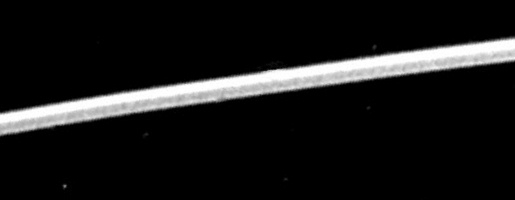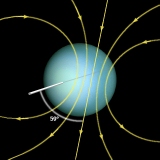 |
|||
|
Highest
resolution Voyager 2 image of Uranus' Epsilon ring.
|
|||
| THE MAGNETIC FIELD OF URANUS | |||
| On its way to Uranus Voyager 2 detected the radio emissions which indicated the presence of a magnetic field. Though it is substantial, the field is not as large as Jupiter's or Saturn's. The sunward boundary of the magnetic field, or magnetopause, is about 460,000 kilometres or 18 Uranus radii from the centre of the planet. | |||
| Uranus' magnetic field is generated by convection and flow of the electrically conducting interior. It is dipolar, resembling a bar magnet, but has several strange qualities. The centre of Uranus' magnetic field is offset, that is, it doesn't coincide with the polar axis of the planet. It is also highly inclined (59o) to the planet's axis of rotation, even more so than Neptune's. Saturn's, by contrast, is aligned with its axis. Earth's and Jupiter's are inclined by just 10o and 11o. The unusually high inclination has led to speculation that Uranus' field is part way through a magnetic reversal. | |||
 Uranus' magnetic field. |
|||
| Magnetic reversals are known to occur in the Earth's field, quite suddenly, but interspersed by periods measured on a geological timescale. Earth's magnetic field has undergone 3 polarity changes every million years or so for the last 60 million years, but it is not a regular happening and there have been longer periods, where 50 million years has elapsed between a reversal. It more probable that Uranus' tilt is not a reversal at all and is a stable configuration. | |||
| Furthermore the field of Uranus is said to be rough, which means that there are parts of the field which are uneven, but varying in a fairly short period of time. This indicates that the electrically conductive region is quite shallow. As trends in the shape of the field die out quickly, if the source were located deep within Uranus then the field would be smoother and less variable. As with other planetary magnetic fields, particles are trapped within the field lines which exit and enter the planet at the poles. The trapped protons and electrons spiral along the field lines giving rise to the aurorae observed at the polar regions. | |||
| Like Saturn, a rapid drop in the number of charged particles is observed at field lines which intersect with satellite orbits. The moons sweep a path through the particles leaving empty spaces. Heavy ions (charged material) from the icy satellites, such as Triton, do not appear to interact with the field. Voyager detected no helium which might have come from the solar wind. But ionised particles derived from Uranus' atmosphere, further out, form a high energy plasma disk - a sheet of charged particles interacting with the magnetic field and conducting electricity. | |||
| The magnetic field of Uranus is undoubtedly complex, what is more, it is set to change over the coming decades. As Uranus' axis of rotation changes, the alignment of the field with the direction of the solar wind will also vary. It will gradually tilt away from, rather than into, the oncoming solar wind. | |||
|
|
|||